Introduction
Three years ago, the new A8 became the first mass-produced car with L3 level autonomous driving function, equipped with 12 ultrasonic sensors, 5 cameras, 4 mid-range radars, 1 long-range radar, 1 infrared camera, and a LiDAR.
In March 2020, Changan Automobile released the first domestically produced L3 autonomous driving system, which was first installed on the Changan UNI-T model. The system uses 5 millimeter wave radars, 6 cameras, and 12 ultrasonic radars as the main sensors.
In fact, the country does not allow the release of L3 at present, and the relevant policies and certification standards are being discussed by the national ministries and commissions. Otherwise, different manufacturers’ autonomous driving standards may pose safety risks when vehicles are on the road.
Anyway, so many sensors require high-speed interconnection, which has spurred the use of SerDes (Serializer / Deserializer) in automotive applications. With increased demand, competition among manufacturers has become unprecedentedly fierce.
Why Use SerDes?
SerDes is a mainstream Time Division Multiplexing (TDM), Point-to-Point (P2P) high-speed serial communication technology. As the name implies, it is a device (IC) that converts parallel data into serial data for transmission and converts received serial data into parallel data. The serializer first converts the data into a form that is easy to transmit at high speed (converting the parallel bus into a serial bus), and the deserializer then converts the transmitted data back into its original format (converting the serial bus into a parallel bus).
Before the popularity of SerDes, chip-to-chip communication was done using a system-synchronous or source-synchronous parallel interface.
With SerDes IC, wiring conflicts can be reduced (serial and without a separate clock line, with the clock embedded in the data stream, solving the problem of clock skew that limits data transmission rates). At the same time, it has strong noise and interference resistance (differential transmission), reduces switch noise, has strong expansion ability, and lower power consumption and packaging costs.
The Game of Automotive SerDes
Currently, high-speed SerDes is mainly used to transmit video signals between cameras and displays. This interface, known in the industry as LVDS (Low Voltage Differential Signal), has the characteristics of high speed (Gbps level), low latency, and low power consumption. While transmitting data, it also has a reverse channel for control signals (back channel), which achieves both transmission of large data and two-way control.From the current situation of in-car SerDes, the SerDes solutions used in automotive applications are essentially dedicated, which means that components cannot be used together unless all components use the solutions from the same chip supplier. Currently, several SerDes manufacturers including TI, Maxim, ROHM, APIX, and Inova Semiconductors are emerging.
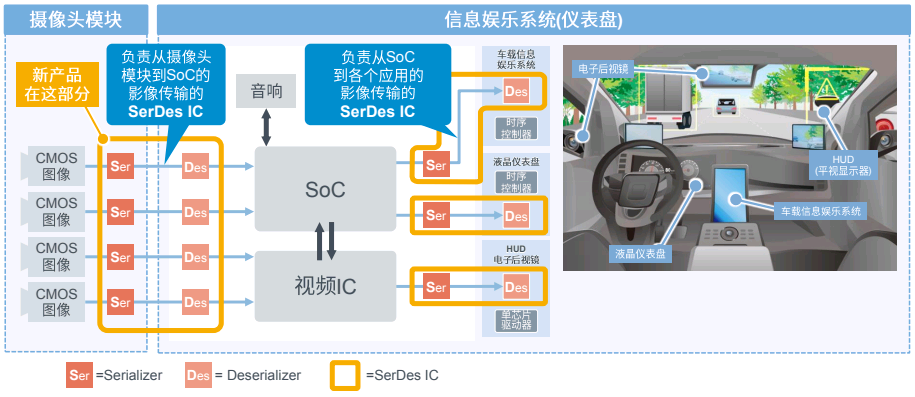
With the installation of millimeter-wave radar and lidar in the future, the number of SerDes used in a car will increase, and the market demand will also increase. As the SerDes solutions vary across manufacturers, automakers have been hoping to establish a unified standard. In 2019, BMW joined several companies to establish the Automotive SerDes Alliance (ASA) to address the above issues, but so far, there is no result.
Challenges brought by camera additions
Although level 3 autonomous driving is not authorized, the development of ADAS (Advanced Driving Assistance System) is encouraged, and it is currently the most realistic application and a hotly contested and innovative area.
The ADAS system is made up of devices with different sensing methods and sensing distances, including the lidar, sonar, and camera. Among them, the in-car cameras in the units such as the parking assistance system play an important role in eliminating nearby blind spots. As a result, each new car model is equipped with approximately 10 cameras.
As ADAS continues to evolve, the number of cameras used also increases, and higher requirements are in place to improve the performance of various cameras. On the other hand, as the number of cameras installed increases, the amount of battery power supply and space available for installing cameras are limited. Therefore, the demand for further reducing the size of the circuit board and power consumption is increasing in the in-car camera module.
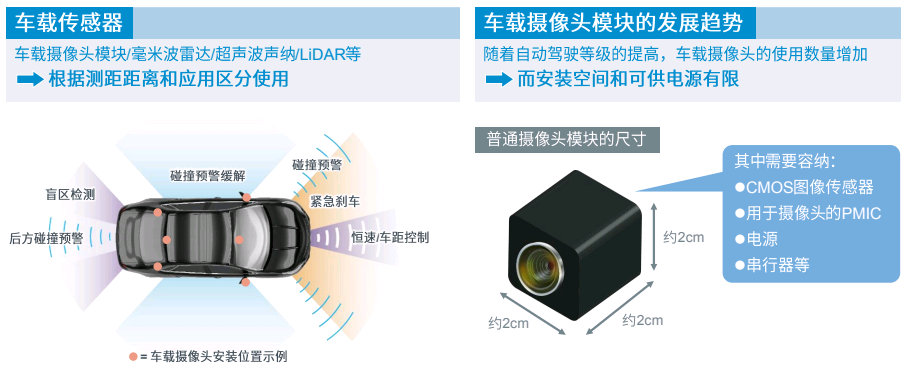
Li Chunhua, the deputy general manager of the technical center of ROHM Semiconductor (Shanghai), pointed out: “The trend of in-car cameras is towards miniaturization. The module size can now be as small as 2x2x2cm. It imposes high requirements on the size to accommodate CMOS image sensors, power management IC, power supply, and serializer. At the same time, power consumption and heat dissipation issues need to be well resolved.”
SerDes + Power management kills two birds with one stone.Recently, Renesas has developed a solution for SerDes IC+PMIC (power management IC) that can meet the SerDes requirements of the ADAS automotive camera module, while reducing the power consumption and EMI (electromagnetic interference) of ADAS.
The SerDes IC for the ADAS automotive camera module is the BU18xMxx-C, and the camera uses the PMIC BD86852MUF-C. Both products can not only meet the requirements for miniaturization and low power consumption of the module, but also have frequency spreading function, which makes EMI lower and helps to shorten the design time of customer EMI countermeasures. The so-called frequency spreading means that the switching frequency is not fixed, but is changed within a certain range, thus spreading the noise energy to a certain width of frequency. By reducing the peak value of noise, EMI noise can be reduced.
The BU18xMxx-C used for image transmission has the following features:
- Optimized transmission rate to reduce power consumption of the automotive camera module
Ordinary SerDes IC sets a fixed transmission rate for each frequency band, and this method cannot finely set the transmission rate, which causes power loss. The BU18xMxx-C has the function of optimizing the transmission rate according to the resolution instead of the frequency band, which can realize a more fine-grained transmission rate setting than ordinary products, with higher efficiency and further reducing the power consumption of the automotive camera module. When this device is installed in an application with 4 camera modules, compared with ordinary products, the power consumption can be reduced by about 27%.
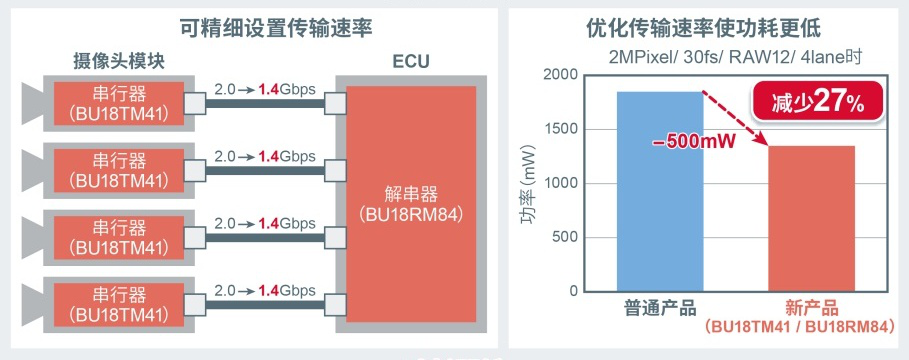
- Built-in transmission rate optimization and frequency spreading to reduce EMI countermeasure design time
By using the transmission rate optimization function to slightly change the transmission rate of each path, the peak value of EMI is dispersed, which reduces EMI by about 10dB. Moreover, by using the frequency spreading function of the serializer and deserializer ICs, EMI can be further reduced by about 10dB. In automotive applications, EMI countermeasure design is a major burden, and the above advantages help to reduce the design time of EMI countermeasures.

- The freeze detection function helps to improve reliability.The IC also has freeze detection function. In addition to the basic function of confirming whether the image is accurately transmitted by comparing the MIPI CRC values from the CMOS image sensor to the deserializer, it can also monitor image freeze by continuously comparing the data frame CRC value of the camera image with its previous and subsequent values in the serializer. If the data frame CRC value remains consistent, an error flag can be output to notify the downstream IC of image freeze issues, thereby improving the reliability of the entire ADAS system.
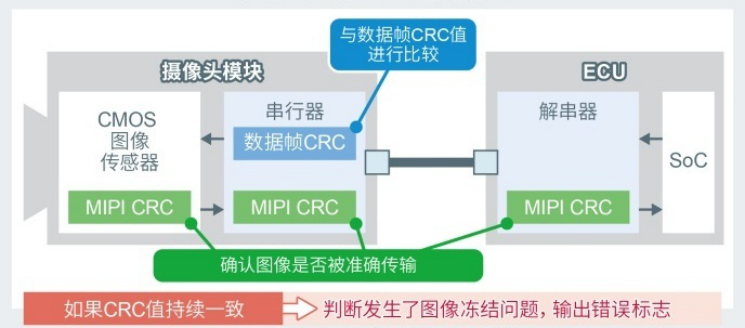
Looking at the power management IC, the BD86852MUF-C used for the camera provides better management functions for the power supply systems of CMOS image sensors from major manufacturers. Since voltage setting and timing control can be performed with only one IC, the installation area can be reduced by about 41%, which helps to achieve miniaturization of the on-board camera module.
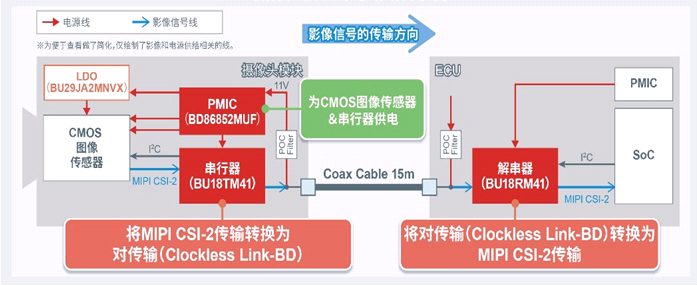
PMIC BD86852MUF-C has the following characteristics:
- Optimized for CMOS image sensors, smaller circuit board area
Different manufacturers have different voltage settings and timing control for driving CMOS image sensors, and many external components are required. BD86852MUF-C is equipped with pins for setting the major CMOS image sensor drive voltage and timing control, eliminating the need for external drive voltage setting and timing control components. Compared with previous products, the number of components and installation area are significantly reduced, which helps to miniaturize the on-board camera module.
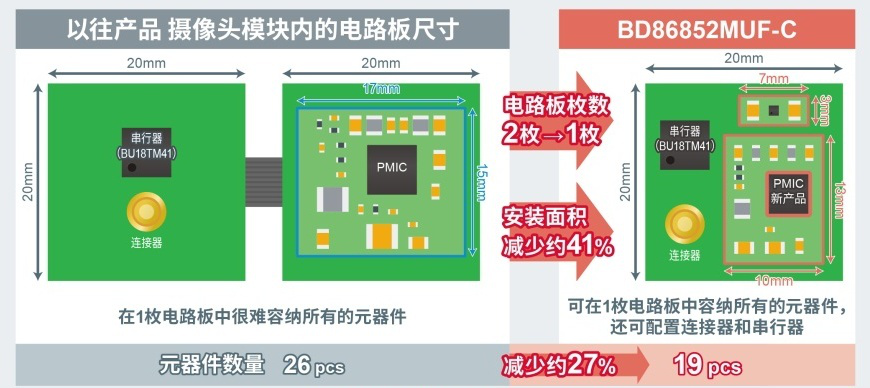
- High conversion efficiency, reduced power consumption
By providing power to the CMOS image sensor through an external LDO, the heat concentrated in the IC can be dispersed, suppressing the heat generated by the entire circuit, achieving up to 78.6% conversion efficiency, which is about 4% higher than ordinary products, and helps to further reduce the power consumption of the on-board camera module. In addition, the distance between the CMOS image sensor and LDO can be shortened, thereby reducing power line interference noise and stabilizing the power supply for the CMOS image sensor.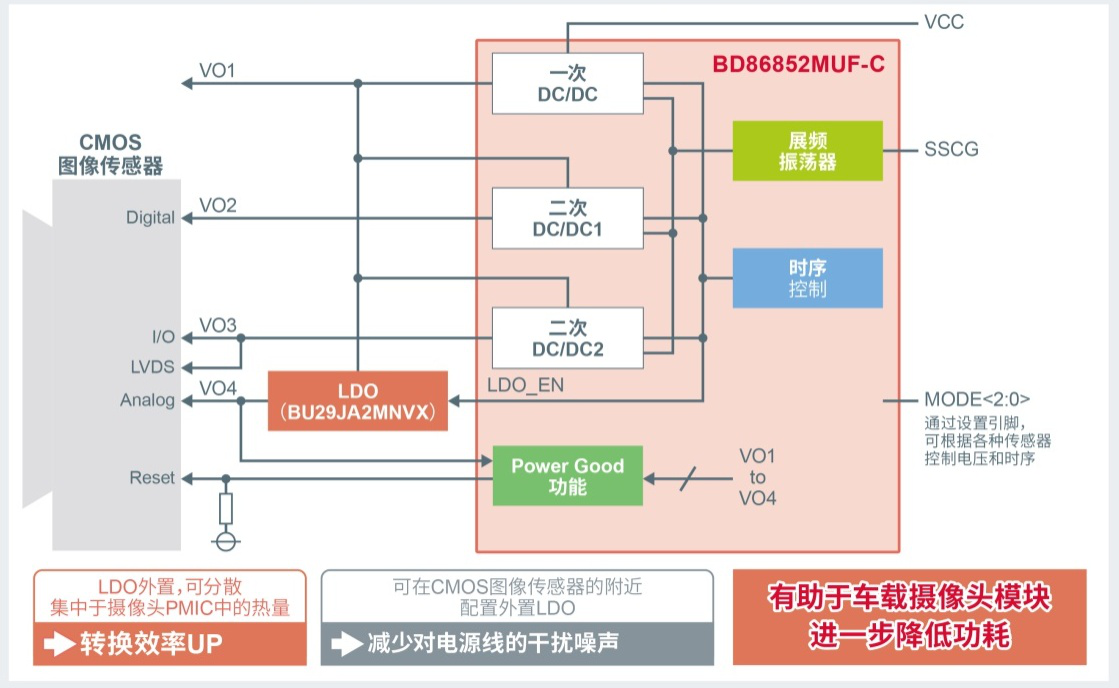
- Spread-spectrum Function Reduces EMI Countermeasure Design Time
The built-in switched voltage regulators (DC/DC converters) are equipped with spread-spectrum function, which can reduce the EMI noise peak caused by switching by about 10dB. This helps to reduce the EMI countermeasure design time without replacing the circuit board, and to lower the noise.
- Built-in Power Supply System Ensures High Reliability
The built-in 3 DC/DC converters provide power to the camera module. In addition to reducing the number of external timing controls, their various protection functions include Power Good monitoring the voltage status. This ensures the high reliability of the camera module, while achieving low EMI and high efficiency power circuits.
According to Li Chunhua, the SerDes IC and PMIC used in this car camera module meet the AEC-Q100 automotive electronic product reliability standard, ensuring the required reliability for automotive applications. In addition, a new PMIC that conforms to the more stringent ISO 26262 certification process requirements is currently under development and is expected to be available this year as a product sample conforming to ASIL-B safety level.
This article is a translation by ChatGPT of a Chinese report from 42HOW. If you have any questions about it, please email bd@42how.com.